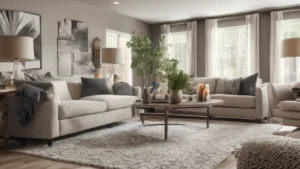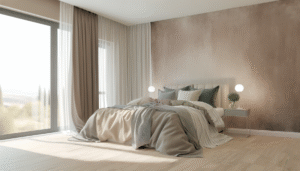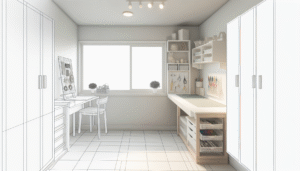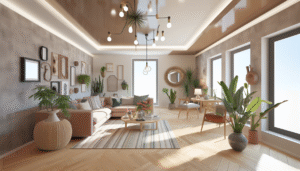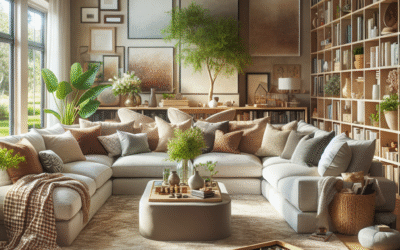<section id="introduction">
<p>Are you overwhelmed by clutter but unsure how to create a serene home environment? Japandi minimalist style offers a perfect solution, blending the elegance of Japanese design with the warmth of Scandinavian aesthetics. This style emphasizes simplicity, functionality, and tranquility, which can transform your living space.</p>
<p>In this guide, we'll explore the principles of Japandi, the importance of neutral colors, and practical tips for incorporating this style into your home. You’ll gain insights into how to achieve harmony, balance, and a sense of calm through your decor choices. Let’s dive in!</p>
</section>
<h2>Understanding Japandi Minimalist Style</h2>
<p>The Japandi aesthetic marries two distinct cultures, creating a unique fusion that resonates with many homeowners today. Understanding its core elements will help you appreciate the style deeply.</p>
<h3>What is Japandi Style?</h3>
<p>Japandi is a blend of Japanese and Scandinavian design philosophies. It celebrates the beauty of simplicity and the idea that less is more, focusing on minimalist aesthetics combined with natural materials.</p>
<h3>The Origins of Japandi</h3>
<p>The roots of Japandi can be traced back to two cultural movements. Japanese design values craftsmanship and nature, emphasizing harmony and tranquility. In contrast, Scandinavian design is characterized by functionality and comfort. Together, they create a refreshing take on minimalism.</p>
<h2>The Role of Neutrals in Japandi Style</h2>
<p>Neutral colors play a pivotal role in achieving the Japandi look. They provide a calming backdrop and allow the beauty of natural materials to shine.</p>
<h3>Key Neutral Colors in Japandi Design</h3>
<ul>
<li>Beige</li>
<li>Greys</li>
<li>Whites</li>
<li>Earthy tones</li>
</ul>
<p>These colors evoke a sense of peace and tranquility, aligning with the core principles of both Japanese and Scandinavian design. Integrating these into your home can enhance your space while maintaining a minimalist aesthetic.</p>
<h3>How to Choose the Right Neutrals</h3>
<p>When selecting neutrals for your space, consider the following:</p>
<ol>
<li>**Light vs. Dark**: Light neutrals can help make a small space feel larger, while darker shades can add depth.</li>
<li>**Warm vs. Cool**: Balance warm and cool tones to create a harmonious atmosphere.</li>
<li>**Texture**: Incorporate textures through textiles and materials to add interest.</li>
</ol>
<h2>Implementing Japandi Minimalism in Your Home</h2>
<p>Transforming your home into a Japandi oasis involves more than just color selection; it's about curating an environment that reflects calmness and functionality.</p>
<h3>Declutter Your Space</h3>
<p>The first step to embracing Japandi style is decluttering. Remove items that do not serve a purpose or bring you joy.</p>
<h3>Selecting the Right Furniture</h3>
<p>Opt for furniture pieces that are functional yet aesthetically pleasing. Look for:</p>
<ul>
<li>Sleek lines</li>
<li>Natural materials</li>
<li>Neutral colors</li>
</ul>
<h2>Decorative Elements to Enhance Japandi Style</h2>
<p>Incorporating decorative elements can elevate your space while adhering to the principles of minimalism.</p>
<h3>Natural Materials</h3>
<p>Choose furnishings made from wood, bamboo, and stone to add warmth while retaining a clean aesthetic.</p>
<h3>Minimalist Art</h3>
<p>Select art that resonates with simplicity. Abstract prints or nature-inspired pieces can enhance the overall look.</p>
<h3>Lighting Choices</h3>
<p>Utilize natural light wherever possible, and when adding artificial lighting, opt for fixtures with clean lines and a minimalist design.</p>
<h2>Creating a Japandi-Inspired Space: Step-by-Step Guide</h2>
<h3>Step 1: Assess Your Current Decor</h3>
<p>Take stock of your current furnishings. Identify what aligns with the Japandi style and what doesn’t.</p>
<h3>Step 2: Choose Your Color Palette</h3>
<p>Opt for a neutral palette with one or two accent colors to maintain harmony.</p>
<h3>Step 3: Invest in Quality Pieces</h3>
<p>When purchasing new items, focus on quality over quantity. Choose pieces that serve dual purposes.</p>
<h3>Step 4: Layer Textures</h3>
<p>Incorporate different textures through rugs, cushions, and throws to create depth.</p>
<h3>Step 5: Add Personal Touches</h3>
<p>Integrate personal elements, such as family photos in minimalist frames, to create a welcoming atmosphere.</p>
<h2>Case Studies: Successful Japandi Minimalism Implementations</h2>
<p>Let’s explore how real homeowners have successfully embraced the Japandi aesthetic.</p>
<h3>Case Study 1: A Small Apartment Transformation</h3>
<p>In a compact urban space, the homeowner transformed their environment by using light neutrals and multifunctional furniture.</p>
<h3>Case Study 2: A Family Home Revamp</h3>
<p>A family opted for earthy tones and natural materials. Their choice of large windows maximized natural light, contributing to the serene atmosphere.</p>
<h2>Conclusion: Embracing Japandi for a Tranquil Life</h2>
<p>By integrating Japandi minimalist style with neutrals into your home, you're not just decorating—you're cultivating a tranquil and harmonious environment. Remember, the essence of Japandi lies in simplicity and functionality. As you embark on your design journey, focus on creating spaces that not only look good but also feel good. Consider starting small and gradually transforming your home into a Japandi haven.</p>
<h3>Next Steps for Your Japandi Journey</h3>
<p>Ready to embrace this beautiful style? Start with decluttering your space, followed by selecting a neutral palette that resonates with you. For more inspiration, check out our related articles! Let’s make your living space a serene retreat.</p>
<h2>FAQs</h2>
<details>
<summary><strong>What is Japandi style?</strong></summary>
<p>Japandi style is a blend of Japanese and Scandinavian design principles, emphasizing simplicity, natural materials, and functionality.</p>
</details>
<details>
<summary><strong>How do I choose a neutral palette for my home?</strong></summary>
<p>Opt for light versus dark shades, balance warm and cool tones, and consider incorporating various textures for depth.</p>
</details>
<details>
<summary><strong>Can Japandi style work in small spaces?</strong></summary>
<p>Absolutely! Japandi style is particularly effective in smaller spaces, as it emphasizes minimalism and multifunctionality.</p>
</details>
<details>
<summary><strong>Is Japandi style expensive to achieve?</strong></summary>
<p>Japandi can be adapted to various budgets. Focus on quality pieces and decluttering to create an effective transformation.</p>
</details>
<details>
<summary><strong>What types of materials are commonly used in Japandi style?</strong></summary>
<p>Common materials include wood, bamboo, stone, and textiles, all chosen for their natural beauty and simplicity.</p>
</details>
<h4>Content Disclaimer</h4>
<hr>
<p>The information provided in this article is for educational purposes only. It is not professional advice; please consult experts for specific needs.</p>
</article>
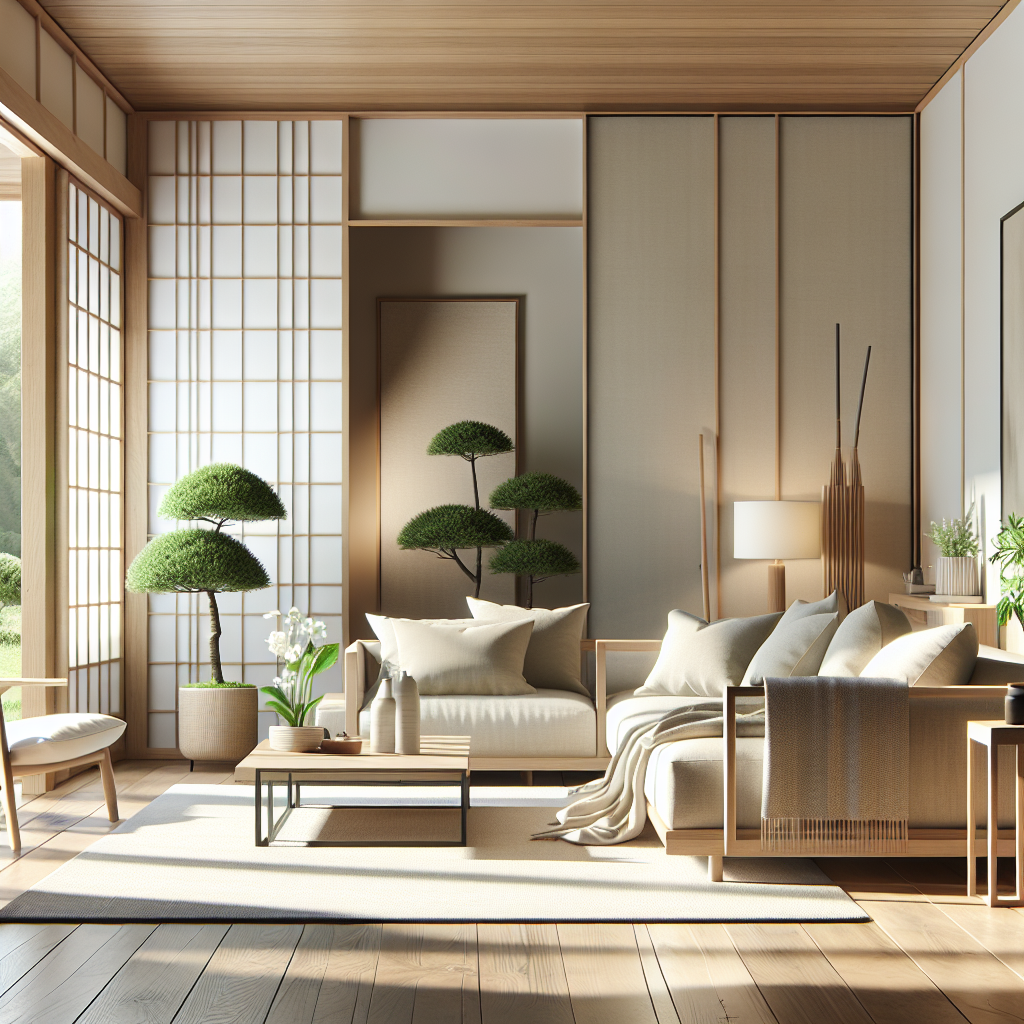
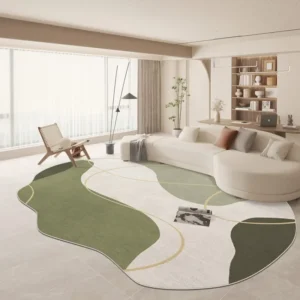 Large Area Green Rugs for Bedroom Nordic Living Room Decoration Shaped Carpet Irregular Plush Lounge Rug Home Thick Washable Mat
Rated 5.00 out of 5$54.94 – $346.41Price range: $54.94 through $346.41
Large Area Green Rugs for Bedroom Nordic Living Room Decoration Shaped Carpet Irregular Plush Lounge Rug Home Thick Washable Mat
Rated 5.00 out of 5$54.94 – $346.41Price range: $54.94 through $346.41 Nordic Style Rugs for Bedroom Morandi Living Room Decoration Carpet Large Area Geometry Lounge Rug Home Cloakroom Non-slip Mat
Rated 5.00 out of 5$39.46 – $597.66Price range: $39.46 through $597.66
Nordic Style Rugs for Bedroom Morandi Living Room Decoration Carpet Large Area Geometry Lounge Rug Home Cloakroom Non-slip Mat
Rated 5.00 out of 5$39.46 – $597.66Price range: $39.46 through $597.66 Irregular Shapes Living Room Decoration Carpet Modern Style Rugs for Bedroom Home Thicken Plush Rug Fluffy Soft Lounge Floor Mat
Rated 4.85 out of 5$55.84 – $347.37Price range: $55.84 through $347.37
Irregular Shapes Living Room Decoration Carpet Modern Style Rugs for Bedroom Home Thicken Plush Rug Fluffy Soft Lounge Floor Mat
Rated 4.85 out of 5$55.84 – $347.37Price range: $55.84 through $347.37
